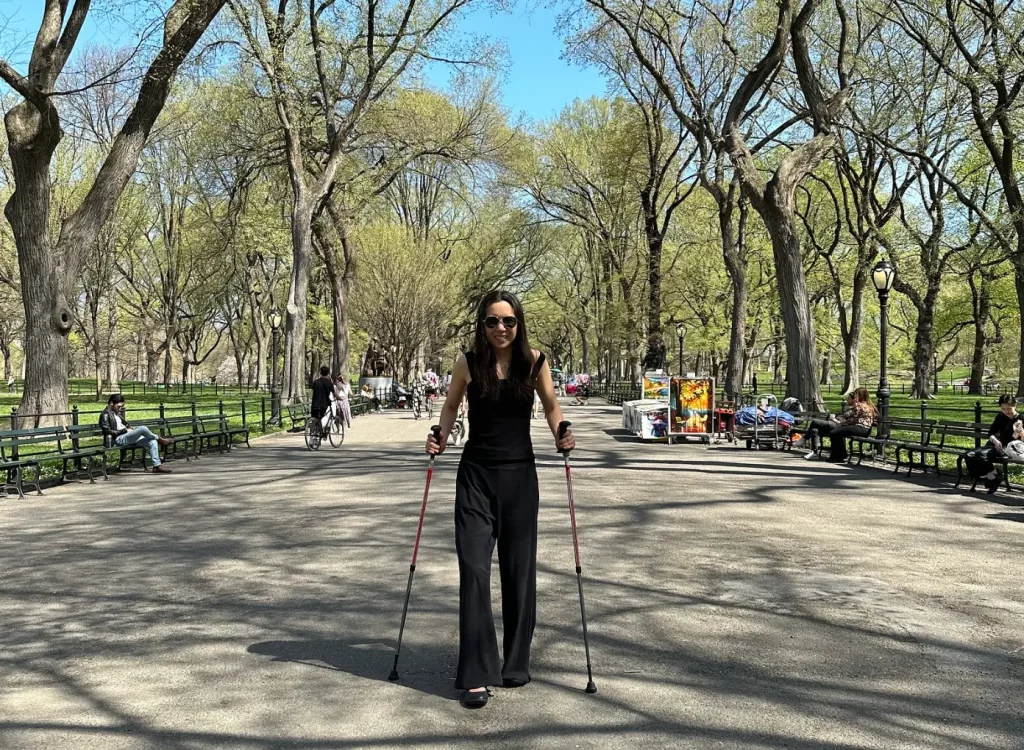
Meet Yulia. She was diagnosed with MS in 1997 when she was 15 years old. Her story is filled with ups and downs — with triumphs and tribulations. Through it all, she has worked hard to manage her MS, give back to others, learn to give herself compassion, and take a proactive role in regaining her mobility. Here is her story.
When you were first diagnosed with multiple sclerosis, what were the first thoughts that went through your head?
“Honestly, that my mother would have reason to love me less than my siblings. She seemed devastated by the diagnosis. That was what made me cry in the doctor’s office, though I soon learned the fear was unwarranted. Closely tied to this was the fear I’d have a harder time not being a burden to my family and society. As a kid, my way of showing value was through my grades, so I wondered, how can I not make MS derail my academic goals?”
How has your mobility changed from when you were first diagnosed with MS until now?
“With my first two MS relapses when I was 14 and 15, I lost the ability to use my right-side upper and lower extremities, I was able to regain the ability to write both times and have almost normal function in my right upper body now, but my right leg never fully recovered from those initial setbacks. I’ve had over a dozen relapses since then, affecting both sides of my body, but the worst damage remains concentrated in my right hip and leg. I also became legally blind at 16 and have reduced sensation throughout my body, which affects my proprioception and balance.
Somehow, in those early years, I was still able to drag myself about NYC and college with my cane, Jack, but my stamina took a hit after college after a series of relapses and chronic infections. I became homebound for six years and could only get about my 350 sq. ft. walk-up apartment. I was always able to walk, but only in very short increments, usually only 30 seconds at a time.
MS also affected my ability to chew food, and medications affected my appetite, so I was seriously underweight for many years. I started using a transport chair outdoors when I was 23 because I did not have the energy to walk after dressing and getting downstairs.
Even when I moved into an elevator building, I did not once go out on my own, as I did not have the strength to push myself in a manual wheelchair at the time. The curb cuts outside my building were inaccessible and it gave me the implicit sense I had no place outside my apartment.
You could say I’d developed learned helplessness and a good heap of internalized ableism, due to all the challenges I was experiencing and the barriers I faced in my environment. My goal at the time was simply to disappear, so people would forget they ever had high hopes for me.
I hit rock bottom at 29 when a long-term relationship ended and I realized I had nothing to live for. Finally living on my own, however, forced me to pull myself together and make better choices for myself and find my own form of independence.
It helped to have to consider only my own needs and not a partner’s. I’ve been dedicated ever since to building up my strength and stamina and to reduce the barriers confronted by other New Yorkers with disabilities.”
How has your mindset changed over time?
“I can’t emphasize enough that getting subsidized housing and other benefits NYC offers low-income people with disabilities was central to improving my mindset. This, in turn, gave me the breathing room to focus on my mobility and lifestyle. Without this baseline security, I would not have had the mental energy to consider what else I could do to improve my life. It’s why I became a financial planner and only work pro bono to help other people with disabilities figure out how to get by in NYC. And it’s why I feel so connected to the mission of the Center for Independence of the Disabled, New York, where I’m on the board.
Finding true acceptance and a purpose beyond myself have also had profound effects on my mindset. Thanks to friends I’ve made in recent years, I can now feel tenderness to the young person who first faced these challenges. I spent too many years faulting myself for terrible choices, which not only led to years of severe depression but also worsened my health and mobility. I’m still learning self-compassion, but I can see at least how it is not worthwhile to beat myself up for not having chosen the perfect diet or exercise routine and gone through with a serious chemo regimen when I was younger.
And with the help of my partner of nine years, I have much more of a growth mindset now and gauge how I am doing not on others’ standards of success but on what is reasonable and healthy for me and aligned with my priorities. I grew up blaming myself for whatever went wrong in my life, but I continually strive to be gentler and more forgiving of myself, at whatever my level of mobility.”
What treatments/therapies/devices have you tried to improve your mobility? What helped and what didn’t help?
“In the first 15 years of my having MS, I relied solely on medications to help prevent relapses and enable me to regain mobility. I’ve taken nine DMTs over the years and am still on one, but now see medication as just one way to help maintain my mobility.
Physical therapy never led to meaningful gains. And just getting to the appointment was a workout for me.”
I got a personal trainer in my 30s, but it was frustrating that he didn’t understand I couldn’t push myself to exhaustion and that I couldn’t carry on a deep conversation while attempting his exercises. I’d fall once or twice per half-hour session and ended up getting a concussion when my chair flipped back after a session. But the final straw was when he told me, as I struggled to do an exercise, that my form didn’t matter.
This went completely counter to what I was beginning to learn from the MS Gym, a virtual gym that I found around this time, designed for MSers and people with other neurological conditions. The creator, Trevor Wicken, gives members a structured workout routine wherever they are in terms of their mobility.
The program has been critical in helping me undo decades of counterproductive compensations and asymmetries by reinforcing blurry movement maps in my brain. The program works out all the muscle groups at just the right intensity and frequency so that I don’t strain my body, and the focus on improving form has led to numerous improvements in my gait, leading me to walk quite fluidly despite serious damage to nerves in my brain, neck and spinal cord.
In the five years since joining the MS Gym, I’ve gone from walking a total of about five minutes a day (the bare minimum needed to go about my day) to 90 minutes most days, broken up into many sets, most as short as 30 seconds to two minutes. But it adds up.
Finally, I see a massage therapist on a weekly basis and learn so much from her about healthy muscle recovery and how to listen to my body. Having her help has been instrumental in reducing my spasticity, recovering from my exercises, and being able to make consistent progress despite continuing to challenge my body every day.”
How did you hear about the Cionic Neural Sleeve? What were your initial thoughts?
“I learned about the Cionic Neural Sleeve through a post from someone in the MS Gym. I’m so grateful I came across it!! I checked out the website and decided that day to get on the waitlist. I’m usually very skeptical about devices because I wasn’t sure if they weakened existing muscles or actually helped people improve their abilities, but it seemed so clear the Cionic was worth trying. The reasonable cost and flexible return policy made it an easy choice.”
How was your first experience with the Cionic Neural Sleeve?
“It completely won me over! I know because I rushed to share my rave review with others who had ordered the Cionic Neural Sleeve. What shocked me was that the sleeve helped the moment it was turned on and set up.
I’d somehow expected it to take several weeks or months for my body to adjust to it and for my strength to build, but when the anterior tibialis and hamstring electrodes were set to the right levels, my right leg immediately fired as they hadn’t in decades and my right leg cleared the floor easily, despite the fact I was exhausted when the onboarding session took place and could barely stand without the sleeve on.
The app was so intuitive to use and I loved seeing all the features it offered, including the exercises I could do with it. These were exactly the exercises I had in mind for targeting the four muscle groups the Cionic Neural Sleeve activates.
As I wrote to the Cionic group on Facebook, ‘I’d already walked 75 minutes by the time I tried the Cionic and was struggling with low energy and dragging my right foot. But with the Cionic on and calibrated, my right foot lifted just like I had peak energy. This is giving me back my afternoons — already!’”
How has the Cionic Neural Sleeve impacted your mobility? (Please describe changes in mobility since you’ve been wearing it, while wearing the sleeve and changes since you’ve been wearing it, not wearing the sleeve)
“Before using the Cionic Neural Sleeve, I had minimal ability to walk in the afternoons. Now, with the sleeve, I can keep up my walking practice throughout the day, which I had long hoped for, for cardiovascular health. My walking speed and stamina improved by 10% in the first week I began using it. And the light compression from the sleeve, whether the device is turned on or not, is terrific for my low blood pressure and the swelling in my right leg.
It is difficult to compare my walking endurance before using the sleeve and now, unfortunately, as I am in the midst of Immune Reconstitution Therapy. A week after getting the Cionic Neural Sleeve, my energy crashed as a side effect of low lymphocytes, as I had expected it would. That said, using the sleeve has enabled me to continue walking through this exhaustion and weakness, which I’ve been grateful for, and I’ve maintained my ability to walk 90 minutes most days, despite my immune system’s rebooting itself.
Without the sleeve on, I continue to experience greater hamstring and anterior tibialis strength. The range of motion in my right ankle has also improved when not wearing the sleeve. And I’m finally able to do minimal knee flexions on my stomach, which had been impossible before. I also find it easier to do tall kneels and clam shells, which I have long struggled with, possibly because my hips are now more balanced. I find progress in these more fundamental movements when not wearing the sleeve is the clearest indication my body is truly improving from using it and not just doing better with it on.
Since starting to use the Cionic Neural Sleeve, whether I have the sleeve on or not:
- I can put weight on both legs when getting up from a seated position
- My right foot clears the floor now when walking and I am able to dorsiflex throughout the day
- I have greater sensation in my right leg and improved balance and proprioception
- My hips are more level, as I am able to put more weight on my right leg
- My shoulders, forearms, and hands hurt less because I am putting less pressure on my trekking poles to stay upright”
What advice would you give to people who are considering ordering the Cionic Neural Sleeve?
“Go for it! It’s like having on-demand physical therapy that not only balances your lower body, but that also increases your strength in one go.
And you don’t have to remain an engaging conversationalist with the Cionic Neural Sleeve as you use it.
You can’t know for certain how your body will respond to the sleeve and stimulation, but it’s so worth it to discover what can happen. The CIONIC team’s enthusiasm, desire to assist, and openness to feedback are all incredible.
When I broached my vision issues with them before even starting to use the sleeve, they did everything they could to make sure I was comfortable with the onboarding, the sleeve, and the app.”
Thank you, Yulia, for sharing your story. Interested in hearing other CIONIC stories? Click here to meet other members of our community.
This is a user story from a Cionic customer, who has not been compensated to share their story. Individual results and experiences may vary. Consult with your doctor on treatment decisions.





